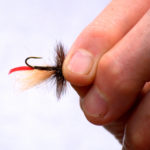
Insects that fall in the water are trout favorites
In the summer, when insect hatches are sparse, trout depend more on what falls into the water than what hatches in it. Terrestrials, or land-based insects, make up the bulk of a trout’s diet from early summer until first frost. Terrestrials include various beetles, grasshoppers, crickets, worms, bees, ants, cicadas, fireflies, damselflies, crane flies and just about any other insect that flies crawls or hops. If it’s an insect that a trout will eat, fly shops will have dozens of different patterns that imitate them, both floating and sinking versions.
One summer when I was fishing Tanasee Creek, a wild-trout stream in Jackson County, I started with an elk-hair caddis pattern, a usually dependable fly, and I couldn’t raise a single trout. I switched to a foam inchworm and cast to a bank overgrown with rhododendron. My first cast didn’t land exactly where I wanted it to, and as I reeled in for another cast, a big brown darted out of the shadows and chased the inchworm to within a few feet of where I was standing. It surprised me so much I missed him. I moved to another spot, cast again and caught a 12-inch rainbow. I fished with that same fly the rest of the afternoon and caught dozens of browns and rainbows.
I had a similar experience on Hazel Creek fishing with a Joe’s Hopper. I caught trout after trout until the fly was so ragged I finally was forced to change. Unfortunately, it was the only hopper pattern I had. Now, I always carry a good supply of inchworm and hopper patterns.
When fishing with terrestrials, presentation isn’t nearly as crucial as when fishing with hatch patterns. Shane Buckner, a guide and manager of Hunter Banks in Asheville, said, “We tell our clients to let the fly land with a resounding plop. There’s nothing graceful about a beetle falling out of a tree and into the water.”
On stocked waters, such as delayed-harvest streams, Buckner said he sight-fishes, casting to a trout’s tail. On wild-trout waters, it’s blind casting.
Buckner’s preferences are black beetles early in the summer, switching to Japanese beetles as they become more prevalent. His other terrestrial choices are hopper patterns, particularly a Joe’s Hopper and a Dave’s hopper, inchworms and ant patterns.
Buckner said unlike hatch patterns, terrestrials can be fished from early morning to dark.
“I’ll usually start with a beetle pattern early in the morning and switch to a cricket pattern later in the evening,” he said.
Ben Elmer, a guide for Brookings in Cashiers, said the three terrestrial patterns that work best for him are beetles — which he fishes wet — hoppers and inchworms. Hopper patterns usually are fished dry, but inchworms can be fished wet or dry, according to the pattern.
As for specific patterns, Elmer said he likes the Fat Albert beetle pattern, the Jack Cabe Hopper and the inchworm. He fishes close to overgrown banks and areas that have a lot of cover. He suggests giving a fly an occasional twitch to simulate a live insect struggling on the water. For large pools and pocket water, he lets flies dead drift.
Kevin Howell, owner of Davidson River Outfitters in Brevard, fishes with ants, beetles and inchworms, insects that fall into the water from trees and shrubs. He also notes if the wind is blowing or if it’s quiet.
“If there’s a puff of wind, trout usually are feeding on ants that blow into the water. Otherwise, it’s beetles,” said Howell, who prefers fishing terrestrials wet, even if it’s a dry pattern. “I use a little weight to make the fly sink.”
Howell said inchworm and ant patterns are very effective after a summer shower washes the insects into the stream.
Howell said his terrestrial choices are a Hot Spot Ant, a black ant pattern with a red dot on its back; Loco Beetle, a Japanese beetle with a foam body; and Kevin’s Caterpillar, which he originated.
Terrestrial patterns should in most cases match the size of the actual insect. Beetle imitations range from a size 12 to 10, inchworms usually are size 10 or 8, ant patterns run 20 to 18, and hopper patterns are sizes 12 to 10.
As for leader and tippet sizes, all three guides agreed that 9- to 10-foot leaders with 5X or 6X tippets work best.
Other terrestrial patterns that work well on mountain streams are Chernobyl Ant, which doesn’t really resemble an ant, but trout love it; pink or red San Juan Worm and Squirmy Wormy, which look like red worms tied on a hook; Ladybug with orange or red body; the Letort or Dave’s cricket, Crane Fly; and the Tellico Nymph, which resembles a yellowjacket.







Be the first to comment